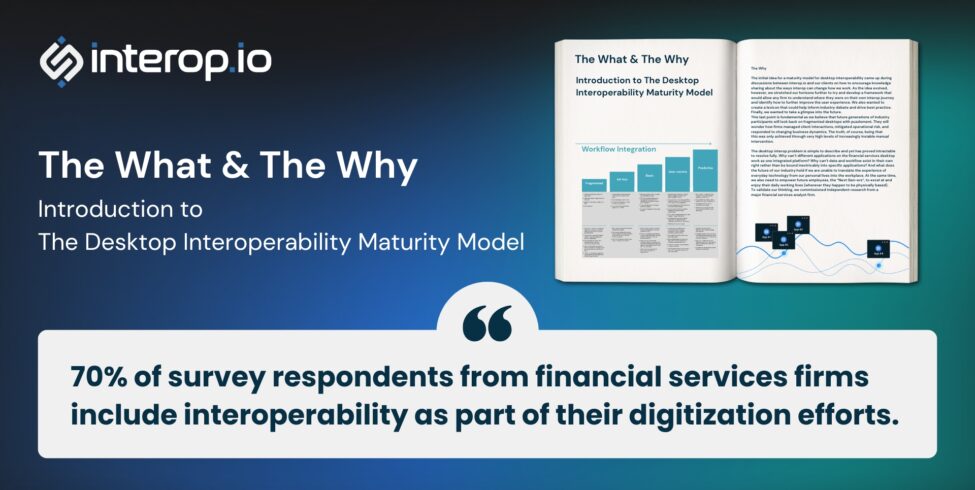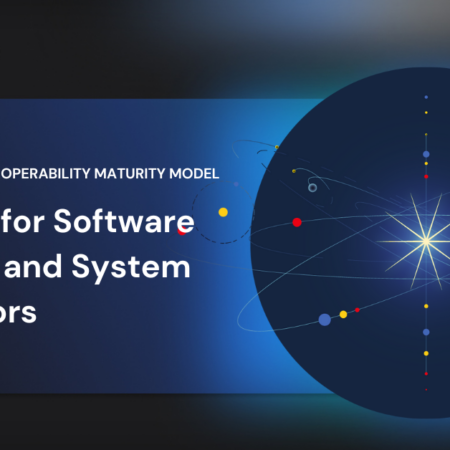Introduction to The Desktop Interoperability Maturity Model
Learn why we decided to partake in the creation of a desktop interoperability maturity model, and our thinking behind the two disciplines that define the model — workflow integration and UI integration.
The Why
The initial idea for a maturity model for desktop interoperability came up during discussions between interop.io and our clients about the ways interop can change how we work. As the idea evolved, however, we stretched our horizons further around developing a framework that would allow firms to understand where they are on their interop journey and identify how to further improve the user experience. We also wanted to create a lexicon that could help inform industry debate and drive best practice.
Finally, we wanted to take a glimpse into the future.
This last point is fundamental as we believe that future generations of industry participants will look back on fragmented desktops with puzzlement. They will wonder how firms managed client interactions, mitigated operational risk, and responded to changing business dynamics. The truth, of course, being that this was only achieved through very high levels of increasingly inviable manual intervention.
The desktop interop problem is simple to describe and yet has proved intractable to resolve fully. Why can’t different apps on the financial services desktop work as one integrated platform? Why can’t data and workflow exist in their own right rather than be bound inextricably into specific apps? And what does the future of our industry hold if we are unable to translate the experience of everyday technology from our personal lives into the workplace?
To validate our thinking, we commissioned independent research from a major financial services analyst firm. Our target group was senior decision makers in the capital markets sector and included 150 respondents. As well as confirming our ideas, the survey also highlighted the need for more detailed study and knowledge sharing in this field. While most respondents got the big picture, many were unsure around the details of desktop interop and integration and how these concepts can be used to achieve effective digital transformation.
The What
Chapters two and three of the eBook explores the background of these problems and the efforts of The Financial Desktop Connectivity and Collaboration Consortium (FDC3) and the Fintech Open Source Foundation (FINOS) to establish some basic standards that enable interoperability. In this way, they seek to set a baseline protocol to allow different applications from different vendors to interoperate with each other. This is important work but, by definition, it will always focus on the lowest common denominator and the minimum required to support basic data exchange. We see FDC3 as a jumping off point. It is the wider capabilities of interop that excite us and motivated us to create this guide.
We then introduce the Desktop Interoperability Maturity Model itself which is initially focused on two core pillars: Workflow Integration and UI Integration. Our aim is to explain each of these pillars at both a business level (what the end user experiences) and at a technical one (guiding those involved in building, implementing, and supporting such initiatives).
We believe that our Maturity Model provides an essential guide for anyone taking desktop interop seriously — buy sides, sell sides, wealth managers, technology vendors, venues, consultants, or commentators.
The final version of the model is based upon months of construction, deconstruction and internal debate followed by rigorous final validation with financial services institutions on the buy and sell side, as well as fintech vendors.
After presenting the model itself, we turn to more practical matters: how to use interop to best effect and where it sits within the spectrum of digitalization that is driving technology investment just as hard in finance as in other industries. Rather than produce simply a “guide for the guide” we chose to incorporate real-life examples of our own experiences and those of others. We felt these would be more tangible to the reader and more useful in shaping their own desktop interop strategy. We’ve also included our list of the top five mistakes firms make with desktop interop and provide advice on how to avoid them. We tried to pick examples based on the key factors in play — focusing on workflow, governance/implementation and selecting the right tools for the job.
The world of desktop interop has come a long way and has been a large part of our working lives over recent years. We are even more excited about its future than ever and its potential to finally make financial services technology work how it should.
Download the eBook for free —>

